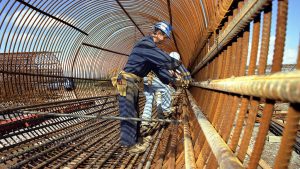With the occurrence of extreme climatic events on the rise, three organizations have partnered to determine how to weather the storm.
A joint-report entitled Weathering the Storms: Municipalities Plead for Stormwater Infrastructure Funding, commissioned by the Ontario Society of Professional Engineers (OSPE), the Residential and Civil Construction Alliance of Ontario and the Ontario Sewer and Watermain Construction Association (OSWCA), confirms stormwater infrastructure in Ontario is under tremendous strain with funding and resources extremely limited.
The purpose of the report was to assess the province’s ability to cope with the impending impacts of climate change and severe weather patterns by looking at the condition of stormwater infrastructure and the type of asset management planning that is carried out in municipalities across Ontario.
Surveys were sent to all 444 Ontario municipalities and 55 were completed and returned. Respondents were asked to remain anonymous and data was collected to generate recommendations for decision-makers. All recommendations centre around the importance for municipalities to develop Stormwater Infrastructure Asset Management Plans.
"Understanding what the condition of municipal infrastructure and stormwater infrastructure is like for municipalities is important for all three organizations," said Mark Hartley, a water resources engineer and OSPE member, adding municipalities need to prepare standalone management plans that include details of both engineered and natural structures including the replacement, operational and maintenance costs. "There are a number of questions that need to be answered. The starting point for us is to say, just like other systems, we need to understand what those assets look like, what is their condition like, so we can provide some foundation to make decisions in the future."
According to the report, it is estimated that $1.2 billion would be needed to replace stormwater infrastructure in six focus municipalities alone, with populations ranging from under 50,000 to more than 750,000. As this funding gap increases across Ontario, so will the economic and environmental impacts caused by deficient stormwater management systems, the report indicates. Fifty-eight per cent of the municipalities that responded to the survey reported limited to no engineered stormwater management infrastructure.
In 2016, 16 municipalities had emergencies that required repairing damaged stormwater infrastructure at an overall cost of $2.1 million.
Municipalities need to have a dedicated source of funding for stormwater systems to mitigate the impact of extreme weather events, said Giovanni Cautillo, executive director of the OSWCA.
"People are starting to get their head around a dedicated system. How to get that dedicated system is to ensure that you have dedicated funds," said Cautillo. "You have a number of municipalities who are now charging a stormwater fee that is then put back into the infrastructure in order to ensure that they have longevity."
While it may be viewed as a tax by constituents, people need to understand why it’s necessary, he said.
"The 100 year storm is no longer every 100 years," said Cautillo. "If you don’t have a system that is able to handle that capacity you’re going to get flooding and the flooding ends up costing everyone in premiums on insurance, in damages being done to their homes, basements, possessions."
Cautillo said it’s important to look at the water system holistically, not piecemeal. In the past, governments have focused on drinking water because of E-coli contamination, as was exemplified in Walkerton, Ont. in a situation that killed seven people in 2000. Then they looked at sewer systems because of the necessity from the health and safety standpoint. Now they are realizing that stormsewers need to be looked at as well because they are all part of the same system.
"Because it’s out of sight, it’s out of mind…nobody puts thought toward it unless it’s a problem," said Cautillo. "When you do have flooding that’s when you say, ‘we may need a bigger pipe here because of capacity issues.’ By that time it’s too late."
The report demonstrates stormwater management assistance needs to be considered a funding priority by the provincial government.
"We can then go with a document to politicians and explain to them there is a need in the industry and the requirement is such that you can’t rest on your laurels, you have to act," Cautillo stated.
The provincial government is looking at regulations with respect to municipal infrastructure and through the report, the partnering organizations are encouraging municipalities to get their stormwater management asset plans started and completed in a timely manner so they are ready when funding does become available, said Hartley.
Some municipalities have started it with their own staff and some of their own funding, while others have said that they are looking to outsource it. Either way, Hartley said it’s a strain on their budget and their existing annual work schedule.
"Their staff already have lots on their plates as it is. By adding this is a challenge for them," said Hartley. "There is a recognition that it needs to be done but there needs to be some resources made available. Whether those resources are financial or staffing or what have you, it’s easier said than done to get these plans prepared."










Recent Comments
comments for this post are closed